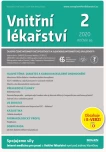Hypoxemia/hypoxia and new concepts of oxygen therapy in intensive care
Authors:
Jan Máca 1,2; Marcela Káňová 1,2; Roman Kula 1,2; Pavel Ševčík 1,2
Authors‘ workplace:
Klinika anesteziologie, resuscitace a intenzivní medicíny LF OU a FN Ostrava
1; Katedra intenzivní medicíny a forenzních oborů LF OU Ostrava
2
Published in:
Vnitř Lék 2020; 66(2): 63-70
Category:
Overview
Oxygen is biologically vital element sustaining life. The tissue oxygen delivery is therefore precisely regulated. The degree of tissue oxygenation is estimated by measurement of oxygen blood level. The lack of oxygen on cellular and tissue level can lead to organ failure and life-threatening condition. Important adaptive processes are activated during the sublethal hypoxia with goal to preserve cellular and tissue functions. Inadequate effort to correct hypoxia can cause either disturbance of the adaptation or undesirable tissue hyperoxia. This fact is taken into account in two currently proposed concepts: (1) precise control of arterial oxemia and (2) permissive hypoxemia. Recent literature supports rather restrictive strategy of oxygen therapy in critical care.
Keywords:
cell adaptation – critical care – hypoxemia – Hypoxia – oxygen therapy
Sources
1. Martin DS, Grocott MP. Oxygen therapy in critical illness: precise control of arterial oxygenation and permissive hypoxemia. Crit Care Med 2013; 41: 423–432.
2. Stub D, Smith K, Bernard S, et al. AVOID Study. A randomized controlled trial of oxygen therapy in acute myocardial infarction Air Verses Oxygen In myocardial infarction study (AVOID Study). Am Heart J 2012; 163: 339–345.
3. Kallet RH, Matthay MA. Hyperoxic acute lung injury. Respir Care 2013; 58: 123-141.
4. del Portillo IP, Vázquez ST, Mendoza JB, et al. Oxygen Therapy in Critical Care: A Double Edged Sword. Health 2014; 6: 2035–2046.
5. Combes A, Bréchot N, Luyt CE, et al. Indications for extracorporeal support: why do we need the results of the EOLIA trial? Med Klin Intensivmed Notfmed 2018; 113: (Suppl. 1): 21–25.
6. Barret K, Brooks H, Biotano S et al. Ganong’s Review of Medical Physiology. 23th ed., New York: The McGraw -Hill Companies, Inc; 2010.
7. Michiels C. Physiological and Pathological Responses to Hypoxia. Am J Pathol 2004; 164: 1875–1882.
8. Semenza GL. Hypoxia -Inducible Factors in Physiology and Medicine. Cell 2012; 148: 399–408.
9. Burša F, Pleva L, Máca J, et al. Tissue ischemia microdialysis assessments following severe traumatic haemorrhagic shock: lactate/pyruvate ratio as a new resuscitation end point? BMC Anesthesiol 2014; 14: 118.
10. Sylvester JT, Shimoda LA, Aaronson PI, et al. Hypoxic pulmonary vasoconstriction. Phys Rev 2012; 92: 367–520.
11. Post JM, Hume JR, Archer SL, et al. Direct role for potassium channel inhibition in hypoxic pulmonary vasoconstriction. Am J of Phys 1992; 262: C882–C890.
12. Wang L, Yin J, Nickles HT, et al. Hypoxic pulmonary vasoconstriction requires connexin 40-mediated endothelial signal conduction. J of Clin Invest 2012; 122: 4218–4230.
13. Marsin AS, Bertrand L, Rider MH, et al. Phosphorylation and activation of heart PFK2 by AMPK has a role in the stimulation of glycolysis during ischaemia. Curr Biol 2000; 10: 1247–1255.
14. Hardie DG, Hawley SA. AMP -activated protein kinase: the energy charge hypothesis revisited. Bioessays 2001; 23: 1112–1119.
15. Boutilier RG, St -Pierre J. Surviving hypoxia without really dying. Comp Biochem Physiol 2000; 126: 481–490.
16. Schumacker PT, Chandel N, Agusti AG. Oxygen conformance of cellular respiration in hepatocytes. Am J Physiol 1993; 265: L395–L402.
17. Semenza GL. Life with Oxygen. Science 2007; 318: 62–64.
18. Eltzschig HK, Carmeliet P. Hypoxia and inflammation. N Engl J Med 2011; 364: 656–665.
19. Schjørring OL, Rasmussen BS. The paramount parameter: arterial oxygen tension versus arterial oxygen saturation as target in trials on oxygenation in intensive care. Critical Care 2018; 22: 324.
20. Abdelsalam M, Cheifetz IM. Goal -directed therapy for severely hypoxic patients with acute respiratory distress syndrome: permissive hypoxemia. Respir Care 2010; 55: 1483–1490.
21. The Acute Respiratory Distress Syndrome Network. Ventilation with lower tidal volumes as compared with traditional tidal volumes for acute lung injury and the acute respiratory distress syndrome. N Engl J Med 2000; 342: 1301–1308.
22. Guérin C, Reignier J, Richard JC, et al. PROSEVA Study Group. Prone positioning in severe acute respiratory distress syndrome. N Engl J Med 2013; 368: 2159–2168.
23. Akmal AH, Hasan M. Role of nitric oxide in management of acute respiratory distress syndrome. Ann Thorac Med 2008; 3: 100–103.
24. Ferguson N, Cook D, Guyatt H, et al. High -frequency oscillation in early acute respiratory distress syndrome. N Engl J Med 2013; 368: 795–805.
25. Combes A, Hajage D, Capellier G, et al. EOLIA Trial Group, REVA, and ECMONet. Extracorporeal Membrane Oxygenation for Severe Acute Respiratory Distress Syndrome. N Engl J Med 2018; 378: 1965–1975.
26. Girardis M, Busani S, Damiani E, et al. Effect of Conservative vs Conventional Oxygen Therapy on Mortality Among Patients in an Intensive Care Unit: The Oxygen -ICU Randomized Clinical Trial. JAMA 2016; 316: 1583–1589.
27. Chu DK, Kim LH, Young PJ, et al. Mortality and morbidity in acutely ill adults treated with liberal versus conservative oxygen therapy (IOTA): a systematic review and meta- -analysis. Lancet 2018; 391: 1693–1705.
Labels
Diabetology Endocrinology Internal medicineArticle was published in
Internal Medicine

2020 Issue 2
Most read in this issue
- Differential diagnosis of hypoglycemia
- Hypoxemia/hypoxia and new concepts of oxygen therapy in intensive care
- Thymoma – diagnostics options
- Diosmin/hesperidin: a cooperating tandem, or is diosmin crucial and hesperidin an inactive ingredient only?
